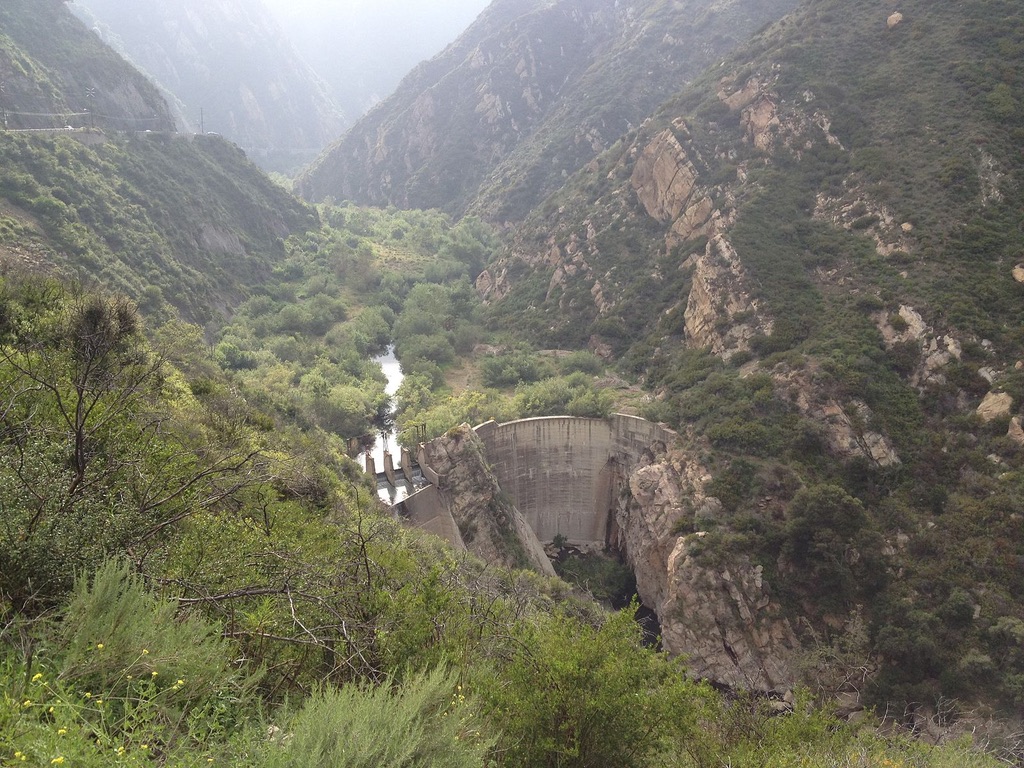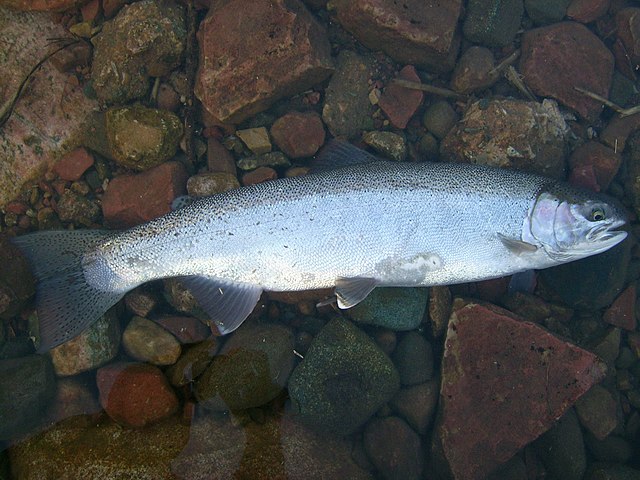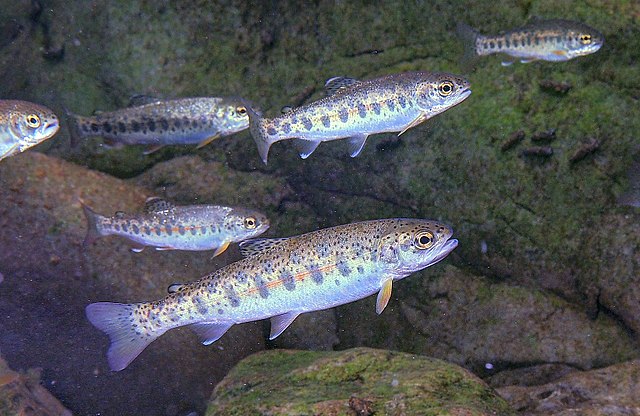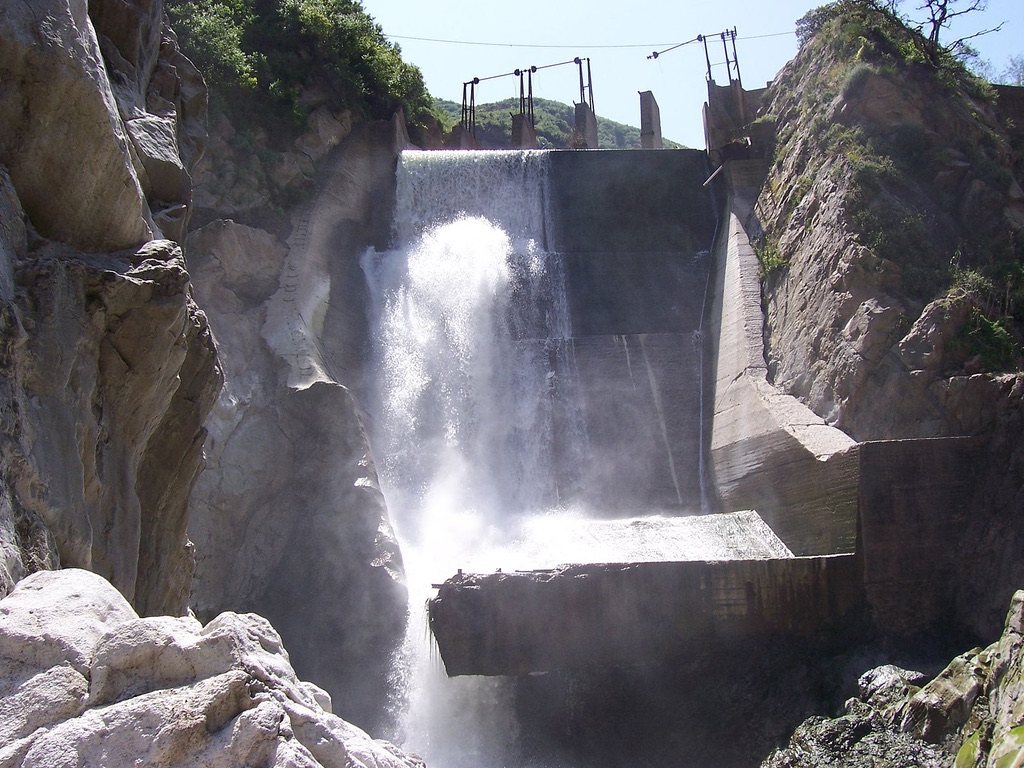
The Rindge Dam in Malibu Canyon near Malibu in Southern California hasn't been functional for decades. (Churnice, CC BY-SA 3.0)

The Rindge Dam in Malibu Canyon near Malibu in Southern California hasn't been functional for decades. (Churnice, CC BY-SA 3.0)
Steelhead trout are a native species in California and serve as an essential part of the state’s economy, cultural heritage, and environment. Their habitats range all over the Pacific Coast in both freshwater and the oceanic saltwater as these fish need both ecosystems for their life cycle. The populations of California’s native fish species are declining; if these trends persist, 74% of native fish will be extinct in 100 years. The factors that contribute to their decline range from agriculture to urbanization to climate change.
In particular, dams pose one of the greatest threats to steelhead trout by blocking the mature fish from reaching their breeding grounds upstream. In 1926, the Rindge Family constructed the 100-foot-tall Rindge Dam in Malibu Creek, California, to supply water for ranching, agriculture, and irrigation. The dam has not been functional for 80 years, no longer serving a purpose while still disrupting the natural ecosystem and blocking the endangered steelhead trout from accessing their native habitats upstream.

Steelhead trout are a critical species for California’s ecosystems to function properly, which helps provide other services for humans. Steelheads are also a sport fish and revenue from fishing them bolsters California’s economy. Since the Rindge Dam no longer serves a purpose, fish biologists recommend that removing the dam will restore natural beauty to Malibu Creek and revitalize the native steelhead trout.
Steelhead trout are a native fish species that were seriously at risk of extinction and assigned the “endangered” designation by the Endangered Species Act in 1997. This legislation sets criteria that determine whether a species is endangered. These criteria include habitat destruction, over-consumption, disease or predation, current regulations, and other man-made factors. Dams pose a specific risk to steelheads because they block their instinctual migration patterns which require them to bury their eggs far upstream in cool water.
Steelheads spend the first month of their lives in eggs buried under small rocks in cold, freshwater streams. They are the size of a gummy bear when they hatch and live between the rocks at the bottom of the stream to hide from predators. Within five weeks, they grow into small fish that spend their days catching tiny bugs in mountain streams. When they reach their teenage years, it’s time to migrate toward the ocean and live near the beach where saltwater and freshwater mixes. Once they are adults, the steelheads are as long as a human arm and migrate northward to colder waters.
When the steelheads are ready to reproduce, they make the treacherous journey upstream to bury their eggs. For many steelheads in Southern California, this section of the journey is cut short by the Rindge Dam which is located just 2.7 miles from the coast. This is in stark contrast to the 500 miles that some steelhead trout would naturally travel to reach the ideal location to bury their eggs.
Steelheads not being able to reach their habitats, means that they are unable to reproduce. These fish are critical in balancing other species by maintaining an even relationship between predators and prey. Therefore, steelhead trout extinction would have resounding ripple effects on the rest of the ecosystem and the services that the ecosystem provides to humans.
There are 1,400 other dams in California which block about 45% of all salmonids’ natural habitats. Salmonids are a family of fish which include steelhead trout, salmon, and char. Dams create a barrier across a stream making it nearly impossible for water, sediment, nutrients, and fish to move past it in either direction. Many of these dams were built for flood control, irrigation, urban water use, or hydroelectric power generation. However, there are a plethora of dams in California which are no longer functional, including the 100 small dams in the state that have already been removed.

The Rindge Dam was decommissioned in 1967 because small particles of sand that are carried downstream would build up behind the dam. There were attempts to remove this sediment, however after every removal, more sediment would just build up again. If sediment is trapped behind dams it isn’t able to move downstream and replenish coastal landscapes.
After its decommissioning, the dam has remained in Malibu Creek. Dams last an average of 100 years and soon enough they will break down and release the water stored behind them. All dams will have to be removed at some point to avoid the destruction that would come if the infrastructure failed on its own. Prioritizing Rindge Dam removal will alleviate stress of removal in the future while restoring steelhead populations now.
Conservation biologists have researched other methods to boost steelhead populations without removing dams. One of the methods is introducing the species into artificial lakes; however this intervention limits the migration patterns that are necessary for steelhead survival. Limiting them to a reservoir prevents the fish from finding the water temperatures suitable for their reproductive needs and often don’t feature the stream habitats necessary for egg burial. Hatcheries can be used to mitigate declining populations, however they produce fish that are quite different from those in the wild by domesticating them and hampering their ability to evolve in the natural environment.
Some dams have installed fish ladders which function as passageways that allow fish to migrate past the blockage. They are a series of ascending pools in which fish can leap to the next pool in the direction they are traveling. While fish ladders have a mixed record of effectiveness, scientists have deemed all of these methods less effective than dam removal.
Scientists are now determining if dam removal is worthwhile by weighing the costs and benefits. A study from 2013 applied a rating system to eight dams in California to measure which dams need priority removal and how much this process would help salmonid populations. This study factored in metrics like populations of salmon, habitat quality, and external stressors on the watershed to determine if dam removal is a worthwhile option.
Each study site was given a score from 0-3, with 0 indicating dam removal is not worthwhile and 3 indicating that it is based on the nine metrics. Then, the scores for each metric were combined. There are many components that could make dam removal more costly than beneficial. For example, the habitat may require extensive restoration in addition to dam removal or the salmonid populations may be too low to recover.
When this rating system was applied to Rindge Dam, the total score came back as 19, which was ranked as high and indicating that there are extensive benefits to dam removal. Out of the eight dams this rating was applied to, the Rindge Dam, along with four dams on the Klamath River, received a high score.

Removal of the Rindge Dam would triple the quality habitat available to steelhead trout. Furthermore, this study determined that Rindge Dam removal has extensive benefits due to the availability of habitat upstream from the dam and limited short-term effects of dam removal. The study concludes that the net positive effects surpass the negative effects since the trout populations are at risk currently and would face little negative impacts following dam removal. The magnitude of benefits from dam removal outweighs the costs since dam removal is expected to increase access to quality habitat upstream and bolster steelhead trout populations.
There are more than 91,000 dams in the United States, all of which affect or alter the natural environment in some way. For many dams, the pros outweigh the cons of keeping them in commission since they can provide hydropower or divert water to areas in need. As for the Rindge Dam, although planning for its removal began in 1992, approval for the design phase of the project was only issued by the U.S. Army Corps of Engineers in 2021.
Since steelhead trout are a sport fish, their population doubling is expected to add $37.5 million to California’s economy. Furthermore, using the Rindge Dam as a case study can help inform future dam removal on other rivers while allowing scientists to study how restoring an ecosystem back to its natural state affects the greater ecology of the area.